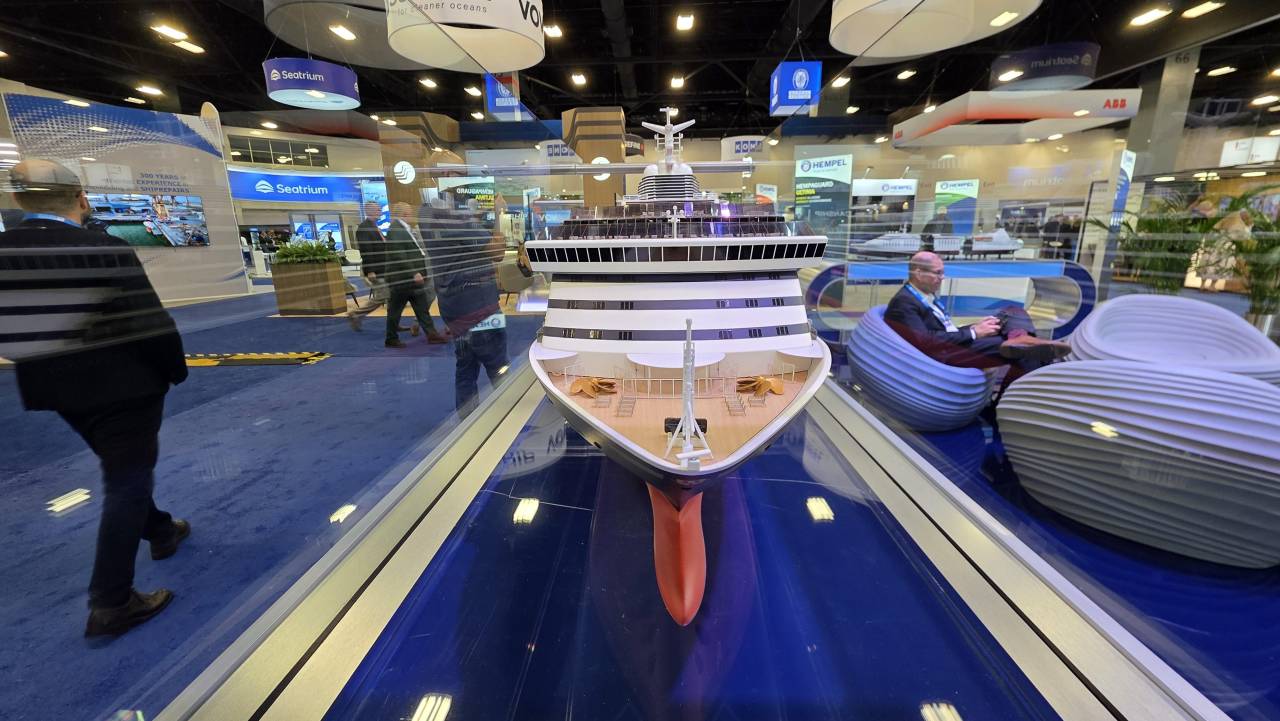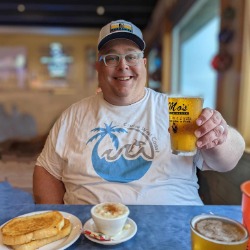This year, I experienced SeaTrade Cruise Global firsthand, immersed in conversations with visionaries planning decades ahead. From food waste biodigesters transforming scraps into water to bubble technology reducing hull friction, the showcased innovations were nothing short of remarkable. Seeing the industry's genuine commitment to sustainability paired with enhanced guest experiences left us truly inspired. Here are ten groundbreaking technologies reshaping the future of cruising, plus a look at the megaship trend heading west.
SeaTrade brings together 11,000+ attendees from over 120 countries, offering a glimpse into decisions that won't materialize for 5-10 years. Each new vessel represents billions invested and years of planning, requiring a delicate balance of technology, infrastructure, political will, and environmental regulations. While Los Angeles could technically dock an Oasis-class ship today, building the supporting regional infrastructure will take 15-20 years. Our candid conversations with industry leaders both tempered expectations and renewed our optimism for the challenging but promising path forward.
Throughout the event, we spoke with maritime executives both on and off the record. We're excited to continue sharing these innovative developments because while they aren't always discussed publicly, they form the essential foundation that makes your cruise experience safer, healthier, more comfortable, and less expensive.
Seamless Connectivity: WMS Technologies' Mobile at Sea
Cruising no longer means disconnecting from the world. WMS has revolutionized onboard connectivity, providing seamless mobile service across more than 200 ships and 25+ cruise lines. Their recent collaboration with AT&T enables the enhanced AT&T Day Pass on cruise ships, allowing travelers to use their existing mobile plans at sea without switching to separate cruise-specific mobile phone and data plans. Verizon's Cruise Daily Pass, now available on more ships through WMS, provides similar convenience and most other carriers are expected to be included soon. This technology enables passengers to use their phones just as they would on land, maintaining important connections during ocean passages.
By removing traditional connectivity barriers and costs, WMS transforms the guest experience for today's digital-dependent traveler.
Zero-Emission Docking: Shore Power Eliminates Port Pollution
Shore power represents one of cruising's most significant environmental advances. This system allows ships to "plug in" to local electrical grids while docked, shutting off diesel engines and cutting emissions by up to 80%. The Port of Seattle is leading implementation, requiring all cruise ships to utilize shore power by 2027. During the 2023 season alone, connected vessels in Seattle avoided emitting 2,700 metric tons of greenhouse gases - equivalent to removing 650 cars from the road for a year.
Beyond Waste: Powerknot's Biodigesters Transform Galley Operations
Food waste management has been completely reimagined with Powerknot's LFC biodigesters. These ingenious systems use aerobic digestion to convert food waste into water within 24 hours, eliminating traditional waste handling. Carnival Corporation has deployed nearly 600 biodigesters across its fleet, achieving a 38% reduction in per-passenger food waste compared to 2019 levels, with aims to reach 40% by 2025. This technology proves especially valuable for ships navigating environmentally sensitive waters.
Cleaner Cruising: LNG and Alternative Fuel Systems Cut CO2 Emissions
The future of cruise propulsion is changing dramatically. Gaztransport & Technigaz (GTT) is pioneering LNG fuel tank technology with membrane containment systems designed for various vessel types. LNG-powered ships generate approximately 20-30% less CO2 than traditional marine fuels while virtually eliminating sulfur oxide emissions. While LNG represents an important transition fuel reducing greenhouse gas emissions, the industry recognizes it as an interim solution rather than the ultimate answer to long-term decarbonization goals.
Smooth Sailing: Reliefband Tackles Motion Sickness Without Drugs
Seasickness may soon become a thing of the past. Reliefband's wearable technology prevents and treats motion sickness without medication through innovative neuromodulation. This FDA-cleared device works particularly well on routes known for rougher waters, enhancing passenger comfort and potentially boosting onboard revenue from activities and dining that guests might otherwise avoid. By eliminating this common cruising discomfort, Reliefband helps travelers fully enjoy their vacation experience.
Bubbles Boost Efficiency: Air Lubrication Cuts Fuel Use by 5-10%
Silverstream Technologies has created an ingenious system that lets ships literally glide on air. Their air lubrication technology creates a carpet of microbubbles along a vessel's hull, reducing friction between the ship and seawater. The result is a 5-10% decrease in fuel consumption and emissions, as verified by Lloyd's Register during testing on Carnival's Diamond Princess. This innovation attracts rapid adoption in new construction and retrofits due to its impressive ROI and environmental benefits.
Advanced Water Treatment Tech Now Likely Exceeds Standards In Your Own Town!
Environmental compliance in sensitive waters demands revolutionary solutions. Evac's advanced water treatment systems employ membrane bioreactor technology that purifies wastewater to standards exceeding many municipal facilities. Norwegian Cruise Line and others have invested in these systems to produce effluent clean enough for discharge in highly protected areas. These sophisticated purification methods help operators maintain their environmental commitments while navigating diverse coastal ecosystems.
Digital Ship Twins: Siemens Technology Optimizes Vessel Performance
The future of ship maintenance is digital. Siemens' digital twin technology creates virtual replicas of physical cruise ships, enabling real-time monitoring, predictive maintenance, and operational optimization. Major cruise lines implement this approach to improve fuel efficiency and minimize maintenance costs. Off-record discussions with executives revealed this technology cuts maintenance expenses by up to 20% while extending vessel lifespans - a critical advantage in managing increasingly complex modern ships.
Renewable Power: GoodFuels Pioneers Marine Biofuel Solutions
Coastal ports serve as laboratories for sustainable cruising. Holland America Line has conducted successful biofuel trials with GoodFuels on vessels like Volendam, using fuels derived from waste cooking oils and other renewable sources. Royal Caribbean's Navigator of the Seas also did a similar test recently sailing from the Port of Los Angeles. These alternatives reduce lifecycle carbon emissions significantly and work in existing engines with minimal modification. Their implementation allows for immediate environmental improvements while the industry works toward longer-term decarbonization goals.
Personalized Cruising: AI Systems Will Transform Guest Experiences
The era of one-size-fits-all cruising has ended. Cruise lines deploy sophisticated AI systems that analyze passenger preferences to deliver tailored experiences. Companies like Lufthansa Industry Solutions develop platforms that predict guest preferences, optimize onboard resources, and reduce food waste through consumption pattern analysis. These intelligent systems help operators differentiate their offerings while enhancing operational efficiency and sustainability.
The Megaship Challenge – Expanding Infrastructure for Larger Vessels
The region will require substantial port development as bigger ships come to California. Los Angeles is already working to expand it's number of berths and shore-side infrastructure to accommodate multiple Oasis-class vessels simultaneously and a new port in Pichilingue, near La Paz, Mexico, is also being designed with mega vessels in mind. Industry stakeholders that I talked with also recognize that the Pacific Coast of Baja California needs an additional port - perhaps a dedicated beach break destination - allowing ships to make shorter stops without traveling all the way to Cabo San Lucas, which will almost certainly always remain a tender port.
The question remains however, will the West Coast cruise market evolve towards embracing the megaship model that dominates the Caribbean or can we maintain the quiet character that many of us passionately enjoy today. I don't think this is an either or situation though. We can have both - emphasizing closer connection to natural environments and cultural experiences while exploring pristine destinations that are on many people's bucket lists. Infrastructure plans indicate a shift toward larger vessels, while discussions about new ports along Mexico's west coast and in Alaska are increasing. This will distribute the port load and prevent overcrowding like we currently face in Skagway, Ketchikan, and Juneau.
While some may say that the arrival of mega ships is inevitable, many experts I talked with hope that even as more cruise lines add Pacific cruise itineraries, they will be committed to preserving the unique appeal of West Coast cruises while embracing the efficiencies of newer, larger ships.
Technology Continues To Enhance The Cruise Experience!
What inspires me most about the cruise industry is its unwavering commitment to improvement. These innovations fundamentally enhance the guest experience while reducing environmental impact. Shore power creates cleaner air in port communities. Biodigesters eliminate unpleasant waste handling. Air lubrication results in smoother sailing. Advanced water treatment protects the beautiful destinations we visit.
The industry demonstrates extraordinary dedication to refining the traveler experience while advancing sustainability. These parallel efforts ensure we'll continue enjoying extraordinary voyages to exotic destinations worldwide for decades to come, with increasingly minimal ecological footprints. As these technologies mature and new innovations emerge, the future of cruising looks brighter and greener than ever.
Thanks for reading. We hope this was helpful!
Why stop now?
Participate In Our Polls | Ask or Answer A Cruise Question | Contact Heather to Book Your Next Cruise!

